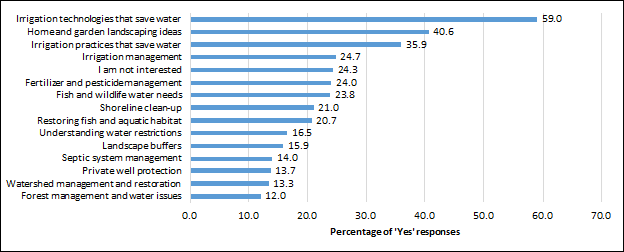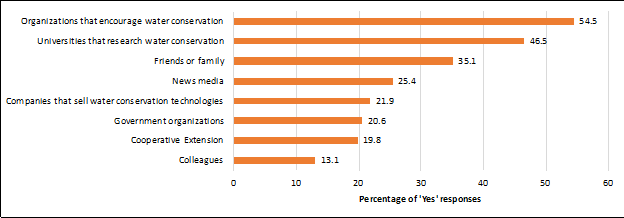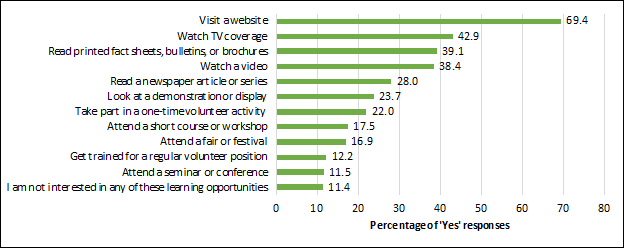 |
October 2017
|
October 2017 // Volume 55 // Number 5 // Research In Brief // v55-5rb3
Characteristics of Home Irrigation Users: Implications for Encouraging Landscape Water Conservation in the United States
Abstract
Home irrigation users are a relatively under-researched target audience for Extension, yet they are major consumers of water. To promote water conservation practices, Extension professionals need to understand key aspects of this group. For example, the home irrigation user participants in the study described here perceive water to be extremely important. They engage in water conservation by following water restrictions, are interested in irrigation technologies that save water, desire home and garden landscaping ideas, and prefer to get water conservation information from websites. However, their interaction with Extension is somewhat limited. To more effectively engage with this audience, Extension should provide relevant water conservation information on well-branded websites.
Introduction
Increases in the population are placing greater pressure on water resources for freshwater supply, food production, and health (Pimentel et al., 2004). As a result, water conservation is an important practice, and encouraging consumers to adopt water conservation strategies is an effort that demands Extension's attention (Kjelgren, Rupp, & Kilgren, 2000; Richetin, Perugini, Mondani, & Hurling, 2014). In 2010, the United States consumed approximately 355 billion gal of water per day for freshwater supply (Maupin et al., 2014). Nationally, outdoor water accounts for approximately 9 billion gal of water per day, and one third of this water is used for landscape irrigation by residential water users (Environmental Protection Agency, 2016). Although 3 billion gal may seem negligible in overall water consumption, it is enough to supply over 34,000 homes in the United States for 1 year (DeOreo, Mayer, Dziegieleski, & Kiefer, 2016), and reducing some of this amount is one of the largest contributions households can make to water conservation. Additionally, in some states, such as California and Florida, residential and commercial landscaping irrigation accounts for more than half of urban water usage (Haley, Dukes, & Miller, 2007; Public Policy Institute of California, 2016). Therefore, best water management practices for landscapes can significantly contribute to water conservation (Shober, Denny, & Broschat, 2010; Warner, Kumar Chaudhary, & Galindo-Gonzalez, 2016).
Because a large percentage of water is consumed by home irrigation users and encouraging people to change existing behaviors can be challenging (Cobourn & Donaldson, 1997), it is important to understand the characteristics of this group so that targeted programs can be developed to help reduce water usage for home irrigation purposes. According to Jorgensen, Graymore, and O'Toole (2009), successful water conservation programs are dependent on the public's perception of water and its various uses. Because literature on the characteristics of home irrigation users is relatively sparse (Warner, Rumble, Martin, Lamm, & Cantrell, 2015), information regarding their characteristics, perceptions of water, and water conservation behaviors is needed (McCammon, Marquart-Pyatt, & Kopp, 2009). Additionally, an understanding of home irrigation users can aid in successful Extension program development targeted toward water conservation practices.
Purpose and Objectives
The purpose of the research reported here was to identify and describe the characteristics of home irrigation users, a group that has a key role in engaging in water conservation practices. The objectives of the study were to describe
- the geographic distribution of home irrigation users,
- home irrigation users' water topic interests and preferred information sources and methods for learning about water topics,
- home irrigation users' perceptions of Extension and other organizations,
- home irrigation users' perceptions about the importance of water, and
- home irrigation users' engagement in water saving practices.
Methods
The study was conducted on a nationwide basis with a sample of 1,620 respondents who were engaged in home irrigation practices. The responses were not weighted by state population as irrigation users are different from the general public and not reflective of the census. Data were collected via a researcher-developed online survey as part of a larger study that captured various characteristics of the target group. The survey was distributed via an online survey company. Nonprobability, opt-in sampling was used because it was considered most appropriate for reaching this population on a national scale in the absence of the possibility of random sampling (Warner, Lamm, Rumble, Martin, & Cantrell, 2016). Because purposive sampling was used, the reader should take caution in generalizing the results, as this population is different from the general population.
Screening questions were used to ensure that respondents were part of the target audience by confirming that they were 18 years or older, had lawn or landscaping adjacent to their residence, and had irrigation systems over which they had decision-making power. Attention filters were used to ensure that respondents answered items accurately. Respondents were asked about the frequency with which they interacted with the local Cooperative Extension service and about their interest in various water topics, preferred sources for water information, preferred methods for learning about water, perceptions of relevant organizations, and use of water-saving practices.
Results
Geographic Distribution of Home Irrigation Users
According to the Environmental Protection Agency (2016), water use varies by geographic location and climate; thus, geographic locations of the target audience are important and have implications for Extension's development of tailored water conservation programs. The states most represented by the study respondents were California (14.0%), Florida (10.0%), and Texas (10.0%) (Figure 1).
Figure 1.
Home Irrigation Users' Residencies by State

Information Seeking Behaviors of Home Irrigation Users
More than half of the respondents (58.1%) reported that they never interact with their local Extension office; however, approximately 28.0% said that they do so at least once every month (Figure 2). It should be noted that although the study addressed frequencies of interactions with local Extension offices, it did not address durations of those interactions.
Figure 2.
Interaction of Home Irrigation Users with Local Cooperative Extension Offices

Respondents were most interested in learning about irrigation technologies that save water (59.0%) and landscaping ideas (40.6%). Respondents were least interested in forest management and water issues (12.0%), water management and restoration (13.3%), and private well protection (13.7%) (Figure 3).
Figure 3.
Home Irrigation Users' Interest in Learning About Water Topics

Respondents were most interested in obtaining information about water conservation from organizations that encourage water conservation (54.5%) and universities that research water conservation (46.5%). Respondents were least interested in obtaining information from colleagues (13.1%) and Cooperative Extension (19.8%) (Figure 4).
Figure 4.
Home Irrigation Users' Preferred Sources of Information About Water Topics

Most respondents preferred to learn about water conservation by visiting a website (69.4%), watching TV coverage (42.9%), and reading certain printed materials (39.1%) (Figure 5).
Figure 5.
Home Irrigation Users' Preferred Methods of Learning About Water Conservation

Water Conservation–Related Perceptions of Home Irrigation Users
Most respondents either agreed or strongly agreed that nonprofit organizations and universities were doing their parts to protect water resources (Figure 6). The largest percentage of "neither agree nor disagree" responses was for Cooperative Extension (51.0%) (Figure 6).
Figure 6.
Home Irrigation Users' Perceptions of Organizations' Roles in Water Conservation

When asked about the importance of water, the majority of respondents (50.4%) indicated perceiving water as extremely important (Figure 7). Additionally, approximately 35% thought water was highly important (Figure 7).
Figure 7.
Home Irrigation Users' Perceptions of the Importance of Water

Most respondents engaged in following water restrictions (89.2%), seasonally adjusting irrigation times (84.1%), using high-efficiency sprinklers (70.7%), and using low-water-consuming plants in their yards (70.6%) (Figure 8). Respondents were least engaged in installing smart irrigation controls (31.5%), using recycled wastewater to irrigate their landscapes (29.8%), and using rain barrels to collect water to use in their gardens (29.0%) (Figure 8).
Figure 8.
Home Irrigation Users' Engagement in Water Saving Practices

Conclusions
Interestingly, most home irrigation users who participated in the study reported here resided in California, Florida, New York, and Texas, four states that continue to bear substantial water conservation issues and have the highest levels of residential irrigation use, as indicated in the 2010 Geological Survey (Maupin et al., 2014). Most respondents did not interact with their local Extension offices and identified their preferred sources of information about water conservation as organizations that encourage water conservation and universities that research water conservation. The latter finding suggests that irrigation users seem to prefer information from sources they perceive as specialists in water conservation over more general sources. Further, home irrigation users may not be aware that the water information they require is available at Extension offices or that Extension services are available in their areas.
Required information for home irrigation users includes information on irrigation technologies that save water, home and gardening landscaping ideas, irrigation practices that conserve water, and irrigation management. These topics are of interest to home irrigation users, indicating their overall interest in adopting water conservation practices. Overall, the study respondents perceived water to be an extremely important issue, and they tended to engage in the water-saving practices of following watering restrictions, seasonally adjusting irrigation times, and using high-efficiency sprinklers and low-water-consuming plants.
Recommendations
Most home irrigation users who participated in the study reported here never interact with Extension offices, yet they desire information on water topics, and their preferred methods for learning about water include using websites and reading printed media. These findings suggest that a gap exists between actual availability of water information from Extension and home irrigation users' perceptions of water information available from Extension. Accordingly, there are opportunities for Extension to better promote and expand on its existing resources on water topics and, ultimately, to become more engaged with home irrigation users, an audience with the potential to conserve substantial amounts of water.
One way in which Extension can help promote water conservation practices among home irrigation users is by addressing topics of interest to them, such as irrigation technologies that save water. The results of the study also highlight topics home irrigation users need to know more about, such as using rain barrels, drip irrigation, and recycled wastewater for irrigation. A well-designed Extension water conservation program should focus on promoting awareness of these and other water conservation practices, ultimately resulting in home irrigation users' adoption of best management practices.
Furthermore, Extension should provide water conservation information through methods home irrigation users prefer and ensure that home irrigation users know how to access the information they seek. Because most respondents indicated a preference for obtaining information by visiting websites, Extension could create additional websites addressing water-related topics of interest to irrigation users. For example, consumers' willingness to adopt conservation practices could be enhanced by Extension's provision of information on websites covering home and gardening techniques and irrigation technologies that conserve water. Additionally, existing websites should be better promoted so that home irrigation users are aware of their existence. Other channels of information dissemination could involve printed media, such as fact sheets and brochures, as home irrigation users preferred these learning resources over workshops and conferences. Also, such printed media could be made available at Extension offices, thereby encouraging more frequent interactions between Extension personnel and home irrigation users.
There also exists an opportunity to improve home irrigation users' perceptions of Extension. Most respondents agreed that universities protect water resources; however, about 45% neither agreed nor disagreed that Cooperative Extension is doing its part to protect water resources. This finding suggests that home irrigation users may perceive universities and Cooperative Extension in their states as separate organizations rather than affiliated ones, and it highlights an opportunity for Cooperative Extension to better promote its role in encouraging water conservation. For example, any websites created by Extension should be properly branded for ease of identification. Moreover, future research might address the use of social media by home irrigation users and whether social media campaigns could be effective in improving both awareness of Extension's water conservation efforts and the impacts of those efforts.
Because home irrigation users strongly perceive national agencies and nonprofit organizations as doing their parts to conserve water resources, there is the potential for collaborative efforts between Cooperative Extension and such entities. As well, respondents' interest in learning about conservation practices from organizations that encourage water conservation suggests further opportunities for partnerships with national agencies and nonprofit organizations. Aligning with organizations known for water conservation efforts and those that are home irrigation users' preferred sources of information could prove impactful in promoting water conservation practices and increasing awareness of Extension services.
Clearly, Extension has an opportunity to improve its engagement with home irrigation users. Extension professionals are encouraged to use the findings reported here to develop tailored programs that meet the needs of this target audience.
References
Cobourn, J., & Donaldson, S. (1997). Reaching a new audience. Journal of Extension, 35(1), Article 1FEA3. Available at: https://www.joe.org/joe/1997february/a3.php
DeOreo, W. B., Mayer, P. W., Dziegieleski, B., & Kiefer, J. C. (2016). Residential end users of water version 2: Executive report. Denver, CO: Water Research Foundation.
Environmental Protection Agency. (2016). Outdoor water use in the United States. Retrieved from https://www3.epa.gov/watersense/pubs/outdoor.html
Haley, M. B., Dukes, M. D., & Miller, G. L. (2007). Residential irrigation water use in Central Florida. Journal of Irrigation and Drainage Engineering, 133(5), 427–434. doi:10.1061/(ASCE)0733-9437(2007)133:5(427)
Jorgensen, B., Graymore, M., & O'Toole, K. (2009). Household water use behavior: An integrated model. Journal of Environmental Management, 91(1), 227–236. doi:10.1016/j.jenvman.2009.08.009
Kjelgren, R., Rupp, L., & Kilgren, D. (2000). Water conservation in urban landscapes. HortScience, 35(6), 1037–1040. Retrieved from http://hortsci.ashspublications.org/content/35/6/1037
Maupin, M. A., Kenny, J. F., Hutson, S. S., Lovelace, J. K., Barber, N. L., & Linsey, K. S. (2014). Estimate use of water in the United States in 2010. (U.S. Geological Survey Circular 1405). Retrieved from http://pubs.usgs.gov/circ/1405/pdf/circ1405.pdf
McCammon, T. A., Marquart-Pyatt, S. T., & Kopp, K. L. (2009). Water-conserving landscapes: An evaluation of homeowner preference. Journal of Extension, 47(2), Article 2RIB5. Available at: https://www.joe.org/joe/2009april/rb5.php
Pimentel, D., Berger, B., Filiberto, D., Newton, M., Wolfe, B., Karabinakis, E., . . . Nandagopal, S. (2004). Water resources: Agricultural and environmental issues. Bioscience, 54(10), 909–918. doi:10.1641/0006-3568(2004)054[0909:WRAAEI]2.0.CO;2
Public Policy Institute of California. (2016). Just the facts. Water use in California. Retrieved from http://www.ppic.org/main/publication_show.asp?i=1108
Richetin, J., Perugini, M., Mondani, D., & Hurling, R. (2014). Conserving water while washing hands: The immediate and durable impacts of descriptive norms. Environment and Behaviour, 1–22. doi:10.1177/0013916514543683
Shober, A. L., Denny, G. C., & Broschat, T. K. (2010). Management of fertilizers and water for ornamental plants in urban landscapes: Current practices and impacts on water resources in Florida. HortTechnology, 20(1), 94–106. Retrieved from http://horttech.ashspublications.org/content/20/1/94.full.pdf
Warner, L. A., Kumar Chaudhary, A., & Galindo-Gonzalez, S. (2016). Extension users and non-users differ in water conservation normative beliefs, intentions, and behaviors. HortTechnology, 26(6), 852–861. doi:10.21273/HORTTECH03484-16
Warner, L. A., Lamm, A. J., Rumble, J. N., Martin, E., & Cantrell, R. (2016). Classifying residents who use landscape irrigation: Implications for encouraging water conservation behavior. Environmental Management, 58(2), 238–253. doi:10.1007/s00267-016-0706-2
Warner, L. A., Rumble, J., Martin, E., Lamm, A. J., & Cantrell, R. (2015). The effect of strategic message selection on residents' intent to conserve water in the landscape. Journal of Agricultural Education, 56(4), 59–74. doi:10.5032/jae.2015.04059




